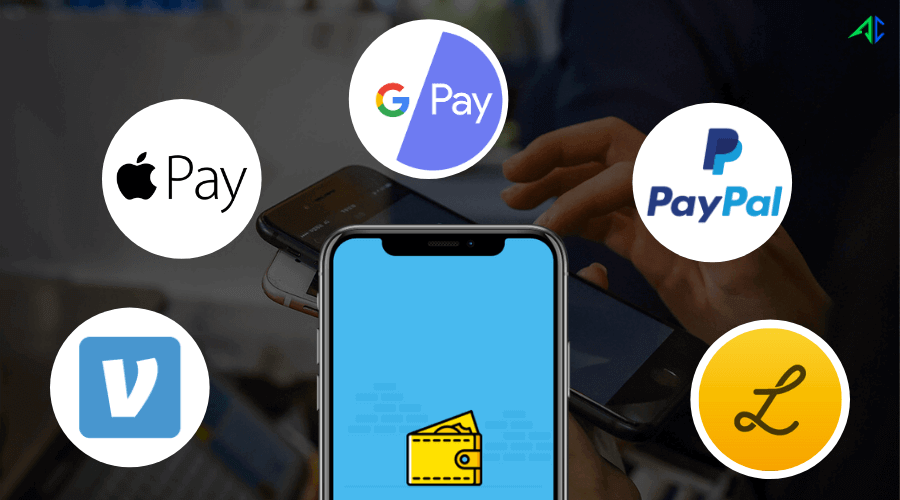Table of Contents
Digital wallets are taking the whole world of online payments by storm. This blog discusses different types of digital wallets that have entirely revolutionized how transactions are made and how these digital wallets can simplify your life in many ways!
Digital wallets are used in making cashless transactions, including online shopping, in-store purchases, paying bills, sending or receiving money, and more. Digital wallets have been around for a while now, but the types of digital wallets are constantly evolving. Many types of digital wallets are available, and they all have their benefits.
Digital wallets are indeed becoming a huge trend. People who use digital wallets in their day-to-day life are well aware of the importance of digital wallets in today’s time. In fact, over the last few years, digital wallets have grown in popularity, attracting more users at a rapid rate. Per a recent report, digital wallets became a $2.4 trillion industry in 2021.
Moreover, mobile consumer purchases and “Peer to Peer” (P2P) payments are fueling the global rise of mobile payment services. Statista predicts that in 2023, there will be 1.3 billion proximity mobile payment transactions users worldwide.
Considering the growing demand for digital wallets, even businesses are consulting leading app development agencies for mobile wallet app development that can easily cater to users’ multi-payment needs and ultimately maximize their ROI.
What Are Digital Wallets?
Digital Wallets (aka E-wallets) are among the fastest-growing types of technology that enable users to make monetary transactions electronically. In other words, digital wallets allow users to use their smartphones or devices in place of credit cards, cash, and even coins when completing transactions online or even at physical stores.
With digital wallets, users can store money digitally and carry out online and offline purchases without using cash. Its ability to encrypt transactions enhances the product by ensuring that your payment is secure.
Top 5 Types of Digital Wallets You Should Know About
Closed Wallet
A type of digital wallet where only selected individuals can send or receive money. An individual or a business that intends to create a closed wallet for personal use may choose not to share with others so that no one except them holds the private key. This is how a closed wallet works.
Semi-Closed Wallet
A type of digital wallet which is used to store, send and receive digital payments. It keeps all the information in one location for safety purposes, but some key or password needs to be shared with another person before making any transaction. A semi-closed wallet provides ease of use by storing multiple public addresses while keeping private keys offline.
Open Wallet
It is a digital wallet that allows users to manage and keep track of their payments online. These wallets are easy-to-use online web applications that can be downloaded onto any device or browser with an internet connection. An open wallet is compatible across platforms, enabling the user to access their transactions anytime from wherever they are in the world.
Crypto Wallet
A type of digital wallet where you can send, receive and store cryptocurrencies. Crypto wallet is one of the most common ways to use cryptos for transactions because they are secure and easy to set up with different blockchains or currencies. A crypto wallet comes in many forms, such as hardware wallets, paper wallets, and mobile apps.
IoT Wallet
A type of digital wallet containing information about the user’s identity is used to store, send, and receive transactions on blockchain technology using IoT devices. The main feature of an IoT wallet is that it can be accessed through devices like watches, smartphones, laptops, etc. An example of this kind of wallet is — Bitcoin.
What Is the Use of Digital Wallets?
People have started gravitating more towards using digital wallets and making online transactions compared to cash transactions. Digital wallets are supposed to serve as online replacements for the traditional leather billfolds that people carry around with them. A digital wallet can be used on nearly any device, including smartphones and computers, acting as an intermediary for some online interactions.
Digital wallets offer many benefits over conventional payment methods, such as saving time, ease of use, etc. Digital wallets can be used to store your credit card information and other sensitive details regarding your finances. It is an excellent alternative to carrying around a lot of cash all the time, especially when you make a lot of purchases online.
What Are the Benefits of Integrating Digital Wallets in Products?
It’s true; mobile payments are taking the world by storm. From Apple Pay to Android Pay, this trend isn’t slowing down anytime soon. The main benefit of these forms of digital wallets is convenience at checkout.
Digital wallets allow users to pay for goods and services with their smartphones or other devices without physically producing their credit cards or cash in most circumstances.
Here are some key benefits of integrating digital wallets in products:
- Reduced paper transactions.
- Fewer chances for theft.
- Eliminate the need for carrying physical cash.
- Customers no longer have to worry about losing their wallets with all their information inside.
- It saves customers time at checkout when they don’t have to fumble through multiple pockets looking for the right card or change.
5 Best (Popular) Digital Wallets for Online Payments
Apple Pay
Apple Pay is a digital wallet provided by Apple Inc. and is available for iOS platforms. It is a contactless payment technology that allows people to use their iPhones to make purchases in stores, apps, and the web. It also enables customers to send/receive money from friends, family, or anyone else. With Apple Pay, users can shop without having to make an account.
Key Features:
- More accessible and Faster Than Cards or Cash
- Accepted at Over 85% of Retailers in the US
- Built-In Privacy and Security
- Touch and Face ID Authentication
Google Pay
Google Pay is a popular digital wallet app available on iOS and Android platforms. With Google Pay, users can shop online at thousands of available stores. With this digital wallet, users no longer have to tap their cards on an NFC machine. They can wave their smartphone, and the device automatically identifies the card linked to the Google account.
Key Features:
- Easy to Set Up and Use
- Send or Receive Money with Zero Fees
- Get Rewards with Every Payment
- Backed with World-Class Security System
PayPal
Paypal is a widely used digital wallet app that is available for both iOS and Android.
The app helps expedite the payment process because it lets you select your PayPal account at checkout instead of entering your information each time you make a purchase manually. Moreover, it allows users to see their past transactions to keep track of spendings.
Key Features:
- Safer with Every Transaction
- Allows You to Shop with Convenience
- Packed with Numerous Features
- Easy Withdrawal via a Bank or Credit Card
- Multiple Currency and Automated Conversion Process
Venmo
Venmo is a popular mobile wallet app available on iOS and Android, used for quick and easy transactions. It was initially designed for smaller transactions, such as splitting a dinner bill among friends. Venmo makes sending money as easy as sending a text message to a friend. It is free to use and keeps users’ activities private if they want to.
Key Features:
- Safeguards Payment Information Using Data Encryption
- Sync with Social Media, Phone Contacts, and More
- Easily Get Linked with Bank Account, Credit Cards, and Others
- Get Rewarded with the Venmo Visa Credit Card
Dwolla
Dwolla is a digital payment network that can transfer money between US bank accounts and credit unions using e-mail addresses or phone numbers. There’s also a feature called “digital wallet,” which stores personal information, so payments are processed within one day of being made! This makes sending/receiving funds, paying employees easier.
Key Features:
- Bank Agnostic
- Branded Experience
- Configurable API
- Scalable Infrastructure
- Tokenization
Final Thoughts
Digital wallets are all the rage these days. With the rapid rise of e-wallets, businesses are also investing in different digital wallet app development types. We hope this blog cleared all your confusion regarding the types of digital wallets, their uses, the benefits of integrating digital wallets in products, and more. If you also want to capitalize on this growing market, the AppsChopper team would be more than happy to help.
We would love to hear your comments relating to the post. Got some other thoughts? Drop us words through our contact page.








